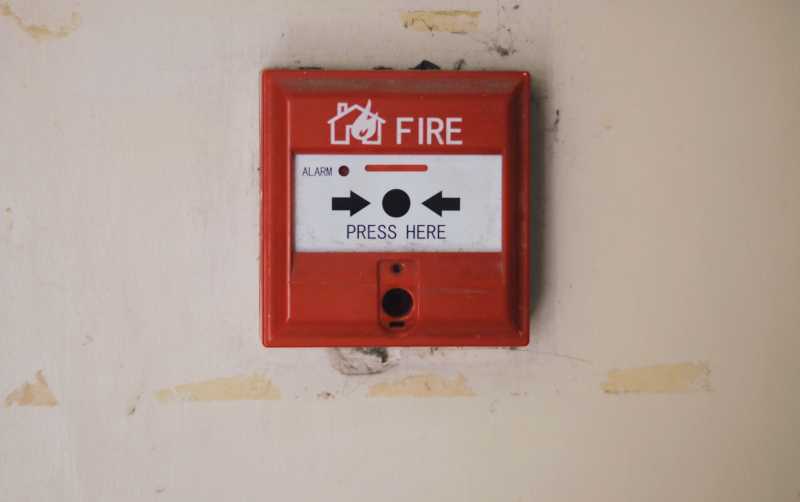Understanding and preventing fire hazards is crucial for every property owner. At Air Duct Cleaning, we believe that a well-informed owner is a safer owner. Our comprehensive guide is designed to help you identify potential fire hazards and take proactive steps to mitigate them. We specialize in cleaning air ducts, a critical but often overlooked aspect of fire prevention. Regular maintenance and cleaning of air ducts not only improves the indoor air quality of your residence or commercial property but also significantly reduces the risk of fire hazards. Our guide will provide you with valuable insights into fire safety measures, the importance of regular air duct cleaning, and practical tips to ensure your property is safe and secure. Stay informed and protect your property with our expert advice.
Understanding the Basics of Fire Hazards

Fire hazards are a significant concern for property owners. Understanding the basics of fire hazards is the first step towards preventing them. Fire hazards can stem from various sources, including electrical equipment, flammable materials, and poor ventilation systems.
Electrical equipment, if not properly maintained, can overheat and cause a fire. Regular inspection and maintenance of electrical appliances and systems can help prevent this. Flammable materials, such as paper, wood, and certain types of fabric, can easily catch fire. Proper storage and disposal of these materials can significantly reduce the risk of fire.
Poor ventilation systems can also contribute to fire hazards. A poorly maintained ventilation system can accumulate dust and debris, which can ignite and cause a fire. Regular cleaning and maintenance of air ducts can help prevent this.
- Regular inspection and maintenance of electrical equipment
- Proper storage and disposal of flammable materials
- Regular cleaning and maintenance of air ducts
"Prevention is better than cure." This adage holds true when it comes to fire hazards. By understanding the basics of fire hazards and taking preventive measures, property owners can significantly reduce the risk of fire.
For more information on how to maintain your ventilation system, visit how air duct cleaning works and how often should air ducts be cleaned. For more tips on preventing fire hazards, check out our blog.
Common Fire Hazards in Residential and Commercial Properties

Property owners, both residential and commercial, need to be aware of the common fire hazards that can pose a significant risk. One of the most prevalent hazards is faulty wiring, which can cause sparks and potentially ignite flammable materials. Overloaded power outlets and extension cords are also a common cause of fires. It’s crucial to ensure that electrical systems are regularly inspected and maintained to prevent such incidents.
Another common fire hazard is the improper storage of flammable materials. These can range from cleaning products and paints in a residential setting to industrial chemicals in a commercial environment. It’s essential to store these materials safely and away from heat sources.
Heating equipment, such as furnaces and space heaters, can also pose a fire risk if not properly maintained. Regular cleaning and inspection can help prevent fires caused by these appliances. Learn more about the importance of regular maintenance from our how important is air duct cleaning page.
Kitchen fires, caused by unattended cooking or grease buildup, are another common hazard. Regular cleaning of cooking appliances and surfaces can help prevent these fires.
Lastly, clogged air ducts can also pose a fire risk. Dust and debris can build up in the ducts and become a potential fire hazard when exposed to heat. Regular air duct cleaning can help mitigate this risk.
By understanding these common fire hazards, property owners can take proactive steps to prevent fires and ensure the safety of their properties. For more information, visit our blog.
The Role of Regular Property Maintenance in Fire Prevention

Regular property maintenance plays a crucial role in preventing fire hazards. It involves a series of activities that ensure all parts of a property, including the air ducts, are in good condition and functioning optimally. Over time, air ducts can accumulate dust, debris, and other flammable materials, which can pose a significant fire risk if not regularly cleaned.
Professional air duct cleaning services can help property owners mitigate this risk. These services use specialized equipment to thoroughly clean the ducts, removing any potential fire hazards. Regular cleaning not only reduces the risk of fire but also improves the efficiency of heating, ventilation, and air conditioning (HVAC) systems, leading to lower energy costs.
In addition to air duct cleaning, regular property maintenance should also include checking and maintaining electrical systems, appliances, and fire safety equipment. Faulty wiring and malfunctioning appliances are common causes of fires, so regular inspections and repairs are essential. Fire safety equipment, such as smoke detectors and fire extinguishers, should be checked regularly to ensure they are functioning correctly.
Moreover, property owners should be aware of the signs that their air ducts need cleaning. These may include a noticeable increase in dust around the property, unexplained respiratory issues among occupants, and a persistent musty odor. By recognizing these signs and taking prompt action, property owners can significantly reduce the risk of fire and ensure the safety of their property and its occupants.
Essential Fire Safety Equipment for Property Owners
Fire safety is a crucial aspect of property management. As a property owner, it’s essential to equip your property with the necessary fire safety equipment to prevent and manage fire hazards. Smoke detectors are a must-have in every property. They provide early warning of fire, allowing occupants to evacuate and call for help. Fire extinguishers are another essential tool. They can control small, contained fires, preventing them from spreading.
Fire blankets are useful for smothering fires, especially in the kitchen where a fire can be caused by cooking oil. Sprinkler systems, though more expensive, can suppress a fire before it spreads, minimizing damage. Fire escape ladders are also important, especially for properties with multiple floors. They provide a safe exit route if the main exits are blocked by fire.
Regular maintenance of these tools is also crucial. For instance, smoke detectors should be tested monthly, and fire extinguishers should be inspected annually.
In addition to these, maintaining a clean and efficient air duct system can also contribute to fire safety. A clogged air duct can pose a fire risk as it can cause overheating. Regular air duct cleaning can help prevent this.
Moreover, understanding how air duct cleaning works can help you ensure that the process is done correctly, further enhancing the safety of your property.
Lastly, it’s important to educate yourself and your occupants about fire safety. Knowledge on fire safety practices can go a long way in preventing fire hazards.
Implementing Effective Fire Safety Measures
Fire safety is a crucial aspect of property management that should never be overlooked. As a property owner, it is your responsibility to ensure that your property is equipped with the necessary fire safety measures to prevent fire hazards. This includes installing fire alarms, fire extinguishers, and fire escape routes. Regular maintenance and inspection of these safety measures is also essential to ensure they are functioning correctly.
In addition to these, maintaining clean air ducts is also an important part of fire safety. Air ducts can accumulate dust and other flammable materials over time, which can pose a fire risk. Regular air duct cleaning can help prevent this. You can learn more about this on our how air duct cleaning works page.
It’s also important to know when your air ducts need cleaning. Ignoring this can lead to a buildup of flammable materials in the ducts. Our how to tell if air ducts need cleaning page provides useful information on this.
Lastly, it’s crucial to hire a professional air duct cleaning service to ensure the job is done correctly and safely. You can find more information on this on our what is the best air duct cleaning company page.
Remember, fire safety is not a one-time task but a continuous process. Regular inspection and maintenance of fire safety measures and air ducts can go a long way in preventing fire hazards.
Legal Responsibilities of Property Owners in Fire Prevention
Property owners have a legal obligation to ensure their premises are safe from fire hazards. This involves adhering to fire safety regulations, maintaining fire safety equipment, and conducting regular inspections. One crucial aspect of fire prevention is the maintenance of air ducts. Over time, dust and debris can accumulate in air ducts, creating a potential fire hazard. Regular air duct cleaning can help mitigate this risk, ensuring a safe environment for occupants.
Moreover, property owners should be aware of the signs that their air ducts need cleaning. These can include visible dust or debris around the vent covers, unexplained respiratory issues among occupants, and a noticeable musty or moldy smell. If any of these signs are present, it may be time to consider air duct cleaning.
In addition to regular maintenance, property owners should also ensure their premises meet all local and national fire safety codes. This can include installing and maintaining fire alarms, providing adequate fire exits, and ensuring all electrical wiring is up to code. Failure to meet these standards can result in legal penalties, including fines and potential liability in the event of a fire.
In conclusion, property owners have a legal responsibility to prevent fire hazards. This includes regular maintenance of air ducts and adherence to fire safety codes. By taking these steps, property owners can help ensure a safe environment for all occupants. For more information, visit our blog.
Case Studies: Lessons Learned from Past Fire Incidents
This section delves into the invaluable lessons that can be gleaned from past fire incidents. By examining these case studies, property owners can gain a deeper understanding of the causes and consequences of fire hazards, and more importantly, how to prevent them. The analysis of these incidents provides a wealth of knowledge on the importance of regular maintenance and inspection of property, specifically focusing on areas often overlooked, such as air ducts.
Air ducts, if not properly maintained, can accumulate dust and debris, which can ignite and cause a fire. The case studies highlight the significance of regular air duct cleaning as a preventive measure against fire hazards. They also emphasize the need for professional cleaning services to ensure thorough and effective cleaning.
Moreover, these case studies underscore the importance of being well-informed about the potential risks and hazards within a property. They serve as a reminder to property owners to stay vigilant and proactive in maintaining the safety of their properties. The case studies also provide insights into the cost-effectiveness of preventive measures, such as air duct cleaning, compared to the financial burden of fire damage repair and restoration.
In essence, these case studies serve as a practical guide for property owners, offering them real-life lessons on the importance of fire hazard prevention and the role of regular property maintenance in ensuring safety.
In conclusion, preventing fire hazards is a crucial responsibility for all property owners. By implementing the strategies and precautions outlined in this guide, property owners can significantly reduce the risk of fire incidents, ensuring the safety and security of their properties and occupants. It is essential to remember that fire safety is not a one-time task but a continuous process that requires regular checks and updates. By staying vigilant, educated, and proactive, we can create safer environments and protect our valuable investments from the devastating effects of fire.





